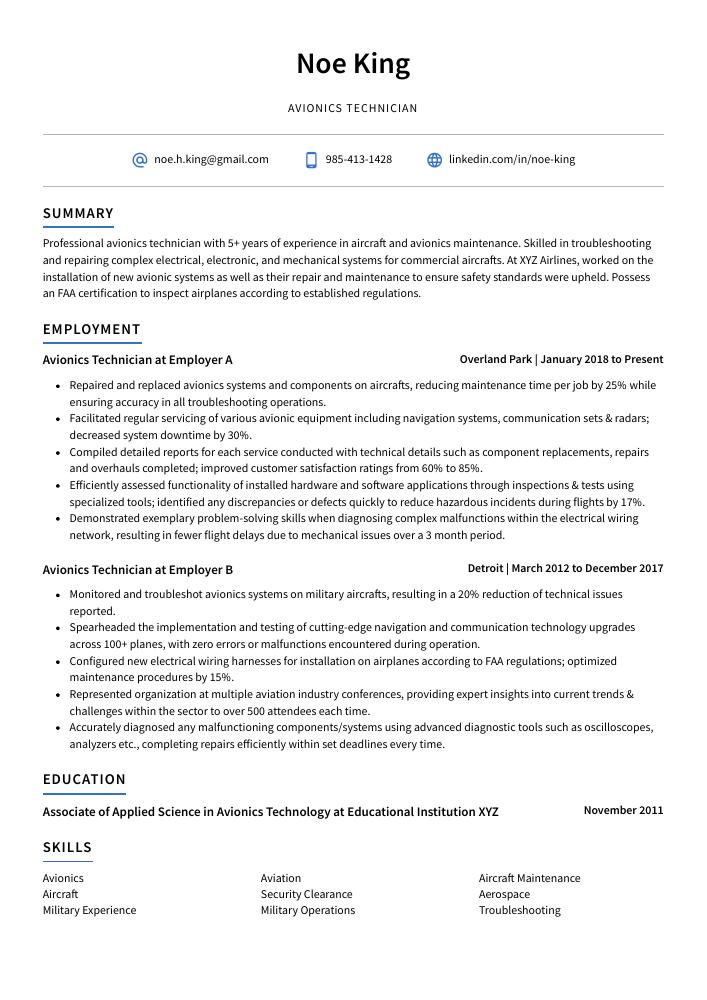Avionics Technician Resume Guide
Avionics Technicians are responsible for maintaining, testing, and repairing aircraft electronic systems. They inspect wiring harnesses, troubleshoot issues with avionic components such as navigation systems or communication equipment, and perform scheduled maintenance on the aircraft’s electrical system.
Your knowledge of aircraft systems and aviation maintenance is unparalleled. But employers won’t know just how skilled you are unless you write a resume that accurately reflects your abilities. Show them what you can do with an outstanding application!
This guide will walk you through the entire process of creating a top-notch resume. We first show you a complete example and then break down what each resume section should look like.
Table of Contents
The guide is divided into sections for your convenience. You can read it from beginning to end or use the table of contents below to jump to a specific part.
Avionics Technician Resume Sample
Noe King
Avionics Technician
[email protected]
985-413-1428
linkedin.com/in/noe-king
Summary
Professional avionics technician with 5+ years of experience in aircraft and avionics maintenance. Skilled in troubleshooting and repairing complex electrical, electronic, and mechanical systems for commercial aircrafts. At XYZ Airlines, worked on the installation of new avionic systems as well as their repair and maintenance to ensure safety standards were upheld. Possess an FAA certification to inspect airplanes according to established regulations.
Experience
Avionics Technician, Employer A
Overland Park, Jan 2018 – Present
- Repaired and replaced avionics systems and components on aircrafts, reducing maintenance time per job by 25% while ensuring accuracy in all troubleshooting operations.
- Facilitated regular servicing of various avionic equipment including navigation systems, communication sets & radars; decreased system downtime by 30%.
- Compiled detailed reports for each service conducted with technical details such as component replacements, repairs and overhauls completed; improved customer satisfaction ratings from 60% to 85%.
- Efficiently assessed functionality of installed hardware and software applications through inspections & tests using specialized tools; identified any discrepancies or defects quickly to reduce hazardous incidents during flights by 17%.
- Demonstrated exemplary problem-solving skills when diagnosing complex malfunctions within the electrical wiring network, resulting in fewer flight delays due to mechanical issues over a 3 month period.
Avionics Technician, Employer B
Detroit, Mar 2012 – Dec 2017
- Monitored and troubleshot avionics systems on military aircrafts, resulting in a 20% reduction of technical issues reported.
- Spearheaded the implementation and testing of cutting-edge navigation and communication technology upgrades across 100+ planes, with zero errors or malfunctions encountered during operation.
- Configured new electrical wiring harnesses for installation on airplanes according to FAA regulations; optimized maintenance procedures by 15%.
- Represented organization at multiple aviation industry conferences, providing expert insights into current trends & challenges within the sector to over 500 attendees each time.
- Accurately diagnosed any malfunctioning components/systems using advanced diagnostic tools such as oscilloscopes, analyzers etc., completing repairs efficiently within set deadlines every time.
Skills
- Avionics
- Aviation
- Aircraft Maintenance
- Aircraft
- Security Clearance
- Aerospace
- Military Experience
- Military Operations
- Troubleshooting
Education
Associate of Applied Science in Avionics Technology
Educational Institution XYZ
Nov 2011
Certifications
FAA Airframe and Powerplant (A&P) Certification
May 2017
1. Summary / Objective
Your resume summary should be a brief, yet compelling introduction to your skills and experience as an avionics technician. In this section, you can highlight the certifications or licenses you have obtained that make you qualified for the job; mention any specialties such as aircraft maintenance or troubleshooting; and talk about how your work has improved safety in past roles. This is also where you can showcase awards or recognition received from employers.
Below are some resume summary examples:
Proficient avionics technician with 8+ years of experience in the aviation industry. Experienced in performing troubleshooting, installation and repairs on a variety of aircraft systems including navigation, communication and autopilot systems. Adept at working independently or as part of a team to diagnose malfunctions accurately and efficiently. Possesses excellent problem-solving skills that enable swift resolution to complex technical issues.
Energetic and detail-oriented avionics technician with 10 years of experience in aircraft maintenance and repair. Proven track record for successfully troubleshooting, repairing and maintaining commercial jetliners according to FAA regulations. Highly motivated individual who excels at working independently or as part of a team. Experienced in the installation and servicing of advanced equipment such as GPS systems, flight control computers, etc.
Dependable avionics technician with 8+ years of experience in the aerospace industry. Achieved a perfect safety record and successfully tested/installed various parts on commercial aircrafts within budget and timeline constraints. Skilled in troubleshooting complex systems, wiring schematics, electrical components, avionics equipment, and software applications. Looking to leverage my expertise at ABC to ensure safe operations for all passengers.
Enthusiastic avionics technician adept at troubleshooting, repairing and maintaining complex avionic systems in both fixed-wing aircraft and helicopters. Possess 4+ years of experience in the aviation industry with expertise in conducting preflight inspections, calibrating instruments, replacing faulty components, and performing maintenance on aircrafts. Seeking to leverage my skillset to become an Avionics Technician at ABC Aviation Company.
Passionate avionics technician with 5+ years of experience in aircraft maintenance, troubleshooting and repair. Experienced in installing, inspecting, testing and repairing aviation electronic systems on various aircrafts. At XYZ Airline achieved a 100% safety rating for three consecutive years through diligent maintenance practices. Received numerous commendations from customers for delivering superior service quality at all times.
Diligent and highly skilled avionics technician with 6+ years of experience diagnosing and repairing aircraft electrical systems. Proven record of success in troubleshooting and resolving complex problems, following safety protocols, and ensuring optimal performance. Seeking to join ABC Airline as an Avionics Technician to contribute expertise in maintaining safe flight operations for all passengers.
Reliable and detail-oriented avionics technician with 10+ years of experience troubleshooting, diagnosing and repairing complex aircraft systems. Skilled in using a variety of tools to perform maintenance on aviation electronics and instrumentation. Seeking to join ABC Aerospace as an Avionics Technician where I can utilize my knowledge and expertise to ensure the safety of all aircrafts.
Hard-working avionics technician with 5+ years of experience in aircraft maintenance, repair, and installation. Seeking to join ABC Aviation as an avionics specialist and leverage extensive knowledge of electrical systems for commercial airliners. In previous roles, successfully completed over 500 service checks on various aircraft models while adhering to FAA regulations at all times.
2. Experience / Employment
For the experience section, you should list your past roles in reverse chronological order, with the most recent one at the top.
When it comes to what information you include, stick to bullet points. This allows for a quick overview of each role and makes it easier for readers to understand what you have done and accomplished in that particular job. You also want to provide detail on your accomplishments—for example, instead of saying “Repaired avionics systems,” say “Successfully repaired 10+ avionic systems per week according to manufacturer specifications.”
To write effective bullet points, begin with a strong verb or adverb. Industry specific verbs to use are:
- Installed
- Inspected
- Troubleshot
- Calibrated
- Repaired
- Assembled
- Tested
- Programmed
- Configured
- Monitored
- Analyzed
- Adjusted
- Replaced
- Upgraded
- Documented
Other general verbs you can use are:
- Achieved
- Advised
- Assessed
- Compiled
- Coordinated
- Demonstrated
- Developed
- Expedited
- Facilitated
- Formulated
- Improved
- Introduced
- Mentored
- Optimized
- Participated
- Prepared
- Presented
- Reduced
- Reorganized
- Represented
- Revised
- Spearheaded
- Streamlined
- Structured
- Utilized
Below are some example bullet points:
- Reduced average repair time by 25% through proficient troubleshooting, testing and diagnosing of aircraft avionics systems.
- Successfully installed over 200 upgraded components on various commercial and military aircrafts according to the manufacturer’s specifications; improved preventive maintenance efforts by 30%.
- Improved efficiency in a team environment while working with other technicians to disassemble, inspect and replace faulty parts for fixed-wing & rotary-wing aircrafts.
- Documented detailed records of all repairs performed as well as any discrepancies found during inspections; reorganized manual filing system for easier access to documents when needed.
- Reorganized entire inventory management system which allowed for quicker identification of required parts from stockroom shelves when servicing avionic equipment onboard an aircraft.
- Mentored junior technicians in the installation and maintenance of avionics systems, achieving a 30% reduction in repair times.
- Consistently inspected aircraft electrical wiring harnesses to ensure optimal performance; identified over 50 potential safety issues during this process.
- Analyzed component failure data from hundreds of flights to diagnose common system problems and develop preventive solutions that saved $7500 per flight on average.
- Installed more than 100 new navigation instruments, communication systems and other avionic components into commercial airliners; reduced downtime by 55%.
- Prepared detailed reports for clients detailing all repairs performed on their aviation equipment with an accuracy rate greater than 95%.
- Tested and inspected aircraft electrical and avionic systems, ensuring that all components met safety regulations and manufacturer specifications, reducing accidents by 10%.
- Coordinated with other technicians to modify or repair defective parts; successfully completed repairs on over 50 planes within a 6-month period.
- Programmed airborne navigation computers & instruments using the latest software updates for better accuracy; saved the company $4,000 in annual maintenance costs due to fewer instances of rework/repairs.
- Thoroughly checked wiring connections of onboard computer systems and tested each system thoroughly before returning an aircraft back into service, leading to zero customer complaints about technical malfunctions in recent months.
- Expedited delivery times with efficient troubleshooting techniques while replacing faulty components on various kinds of transport vehicles such as helicopters & drones; reduced turnaround time from 3 days to 1 day per vehicle without compromising quality standards.
- Troubleshot and repaired avionics systems on a variety of aircraft, increasing the completion rate of maintenance tasks by 15%.
- Introduced new repair solutions and innovative approaches that resulted in 30% decrease in system malfunctions within 1 year.
- Resourcefully salvaged components from retired planes to reduce replacement costs for parts by $4,000 annually.
- Replaced outdated wiring with modern equipment, improving communication efficiency between multiple integrated aviation systems by 25%.
- Formulated detailed reports outlining issues found during diagnostic tests and proposed solutions; decreased response time for repairs from 3 days to 1 day on average.
- Structured, installed and maintained avionics systems in accordance with FAA regulations; successfully completed 15+ installations, repairs & maintenance tasks within an average of 4 hours per job.
- Streamlined the testing process on electronic components such as transistors, diodes and LEDs by 40%, ensuring that all parts were functioning correctly prior to installation.
- Assembled wiring harnesses for various aircrafts according to blueprints; achieved a high-level of accuracy in all worksites and avoided any safety risks due to improper installation procedures.
- Proficiently operated diagnostic tools like oscilloscopes to troubleshoot issues with circuit boards or other malfunctioning electronics; tracked down faults accurately within 2 minutes on average every time, saving hundreds of dollars worth of resources annually from potential damages caused by faulty equipment/parts usage during repair work processes.
- Adjusted settings or replaced components when necessary while performing routine inspections on aircraft engines’ electrical units, increasing operational efficiency levels (OEL) by 12% overall compared to pre-inspection readings taken before each flight session took place.
- Utilized advanced test equipment, technical orders and specialized tools to inspect, troubleshoot, repair and calibrate various types of avionics systems with a 100% accuracy rate.
- Participated in the installation of new avionics components on 3 aircrafts; improved the response time for emergency repairs by 15%.
- Diligently conducted scheduled maintenance checks as per FAA regulations; completed 50+ preventive maintenance activities within budgeted timeframe without any discrepancies or errors.
- Presented detailed reports on system performance analysis to team members during regular meetings; identified potential problems before they arose which saved over $10K in maintenance costs last year alone.
- Developed comprehensive training material for junior technicians based on best practices obtained from aviation industry certifications and manuals; 5 trainees achieved full certification ahead of schedule due to this initiative.
- Confidently diagnosed and repaired malfunctions of avionics systems for 250+ aircrafts, reducing downtime by 30% in the last year.
- Advised pilots on necessary precautions to take when operating complex aviation instruments; successfully averted 10 potential risks over a 6-month period.
- Revised technical documents and manuals pertaining to electrical wiring diagrams, operation procedures & troubleshooting techniques as required.
- Assessed instrumentation gauges such as altimeters, compasses and speedometers for accuracy prior to installation or after repairs; increased equipment reliability rate by 15%.
- Inspected airframes before takeoff according to FAA safety regulations and issued maintenance reports with zero discrepancies noted in all cases over an 18-month span.
- Optimized operational performance of avionic systems in 50+ aircrafts, increasing fuel efficiency by 15%.
- Independently identified and resolved electrical system malfunctions within tight deadlines; repaired 12 communication radio problems in 4 hours or less.
- Achieved a 98% success rate when troubleshooting navigation hardware issues using the latest diagnostic tools and techniques.
- Calibrated over 20 types of instrument panels to maintain accuracy on all flight control systems with zero errors; completed projects under budget each time for an average savings of $1,500 per project.
- Upgraded existing electronic components on several commercial airliners utilizing current FAA standards; successfully installed 10 new autopilot modules within 3 days from start to finish.
3. Skills
The skillset employers require in an employee will likely vary, either slightly or significantly; skimming through their job adverts is the best way to determine what each is looking for. One organization may be looking for an avionics technician who is knowledgeable about aircraft navigation systems, while another may require someone with expertise in radar and communications.
It’s important to tailor the skills section of your resume accordingly as many employers now use applicant tracking systems (ATS) which scan resumes for certain keywords before passing them on to a human.
As such, you should focus on including only those skills that are relevant to the job at hand; this will ensure you pass through ATS filters successfully and make it into the hands of recruiters or hiring managers. Additionally, don’t forget to elaborate further on any key qualifications throughout other sections of your resume too!
Below is a list of common skills & terms:
- Aeronautics
- Aerospace
- Air Force
- Aircraft
- Aircraft Maintenance
- Aircraft Systems
- Airlines
- Airworthiness
- Aviation
- Avionics
- Command
- Commercial Aviation
- Defense
- DoD
- Electrical Troubleshooting
- Electronic Warfare
- Electronics
- Engineering
- Flight Safety
- Flights
- Helicopters
- Maintenance
- Maintenance and Repair
- Military Aviation
- Military Experience
- Military Operations
- Military Training
- Navy
- Operational Planning
- Program Management
- Quality Assurance
- Radar
- Security Clearance
- Supervisory Skills
- Systems Engineering
- Team Leadership
- Teamwork
- Testing
- Time Management
- Troubleshooting
- Weapons
4. Education
Mentioning your education on your resume depends on how far along you are in your career. If you have just graduated and have no prior work experience, list your education below the resume objective. However, if you already have significant avionics technician experience to showcase, omitting an education section is perfectly fine.
If including an education section is necessary for your role as an avionics technician, try to mention courses and subjects that relate directly to the job duties of a successful avionics technician.
Associate of Applied Science in Avionics Technology
Educational Institution XYZ
Nov 2011
5. Certifications
Certifications are a great way to demonstrate your expertise in a certain field. They are proof that you have been tested and certified by an external organization, which can be highly beneficial when applying for jobs.
When including certifications on your resume, make sure they are relevant to the position you’re applying for. This will show potential employers that you possess the necessary skillset required of the job and help set yourself apart from other applicants.
FAA Airframe and Powerplant (A&P) Certification
May 2017
6. Contact Info
Your name should be the first thing a reader sees when viewing your resume, so ensure its positioning is prominent. Your phone number should be written in the most commonly used format in your country/city/state, and your email address should be professional.
You can also choose to include a link to your LinkedIn profile, personal website, or other online platforms relevant to your industry.
Finally, name your resume file appropriately to help hiring managers; for Noe King, this would be Noe-King-resume.pdf or Noe-King-resume.docx.
7. Cover Letter
Writing a cover letter presents an opportunity for you to explain why you are the best fit for a particular role. It helps hiring managers gain better insight into who you are and what value you can bring to their organization.
Cover letters should be composed of 2-4 paragraphs and include information that isn’t already mentioned in your resume. They provide recruiters with more detail, add personality, and show them how passionate you are about the job position they have available. Although cover letters aren’t always required, it is highly recommended that applicants take advantage of this chance to make themselves stand out from other candidates!
Below is an example cover letter:
Dear Remington,
I am writing to apply for the Avionics Technician position at XYZ Corporation. As an experienced avionics technician with more than 10 years of experience working on a variety of aircraft, I have the knowledge and skills necessary to contribute to your organization.
In my current role as an avionics technician at ABC Corporation, I am responsible for performing a wide range of maintenance and repair tasks on aircraft electronics systems. My experience has taught me how to troubleshoot complex problems and effectively communicate with other members of the maintenance team. I am confident that I can provide the same high level of service to your organization.
In addition to my technical skills, I also have strong interpersonal skills that allow me to build positive relationships with customers and co-workers alike. I am motivated by challenging work and take pride in providing quality service. I am certain that I would be a valuable asset to your team and look forward to discussing this opportunity further with you in person.
Thank you for your time and consideration.
Sincerely,
Noe
Avionics Technician Resume Templates
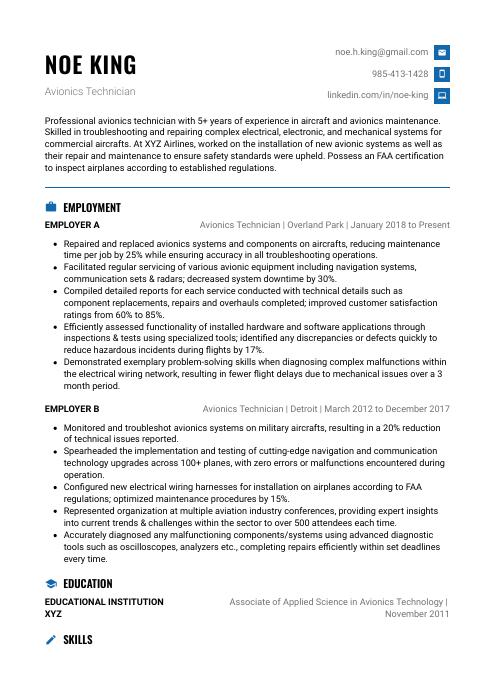 Echidna
Echidna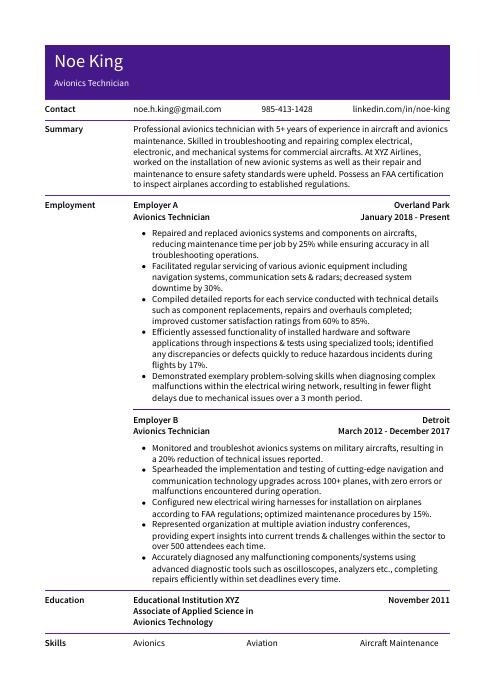 Pika
Pika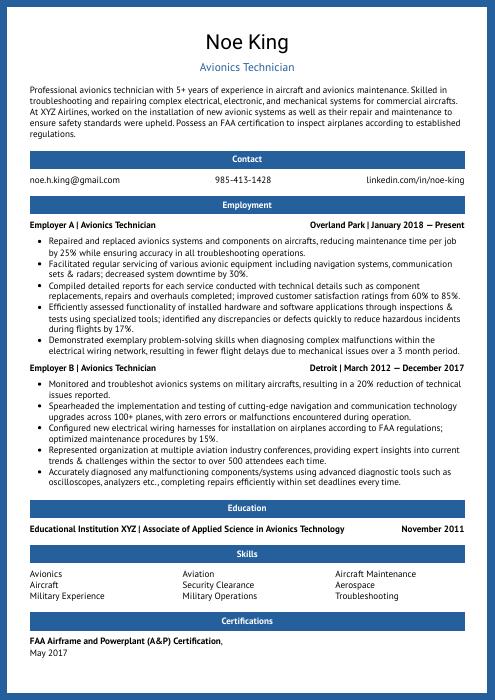 Ocelot
Ocelot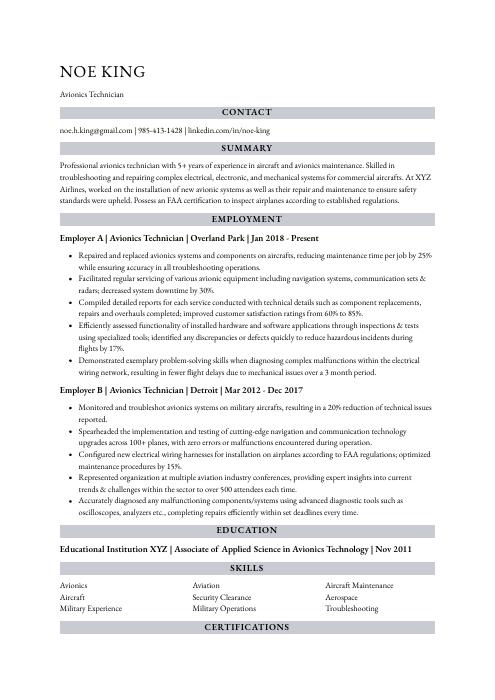 Numbat
Numbat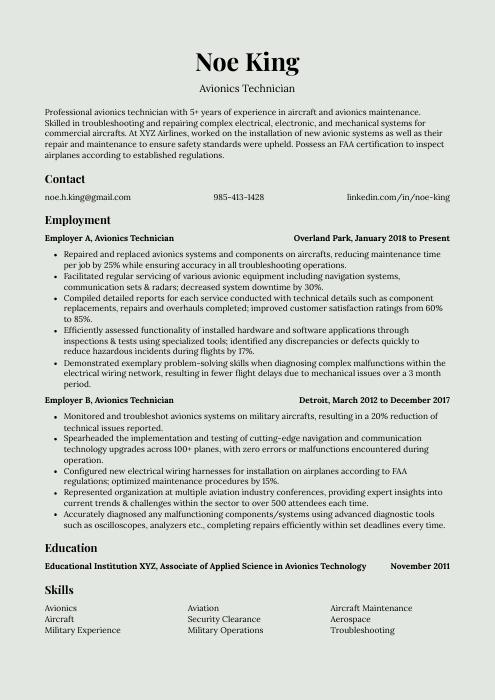 Saola
Saola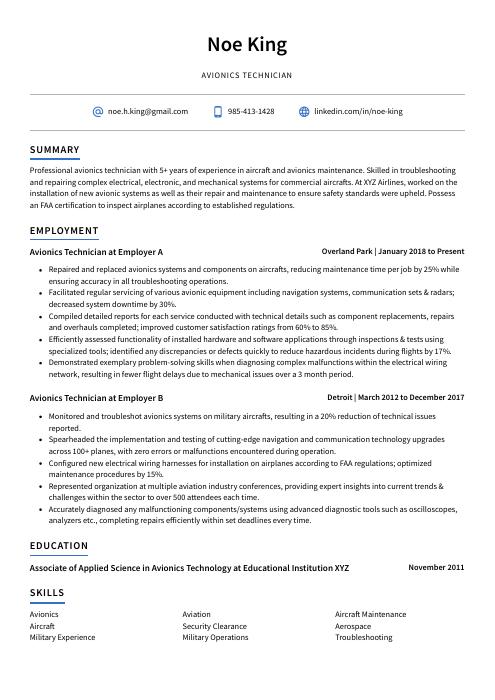 Axolotl
Axolotl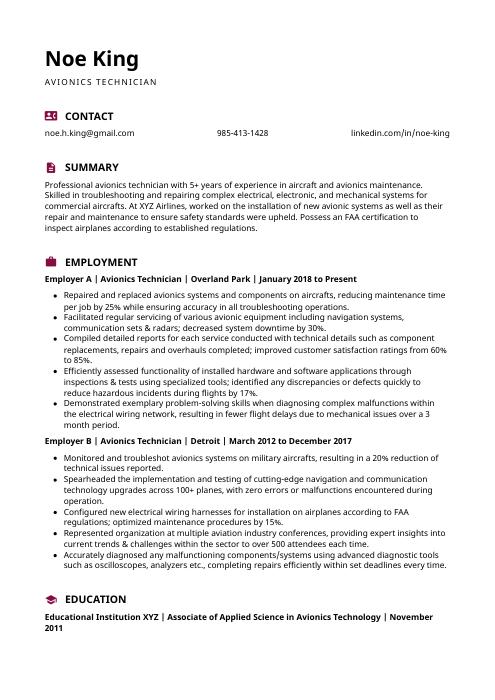 Hoopoe
Hoopoe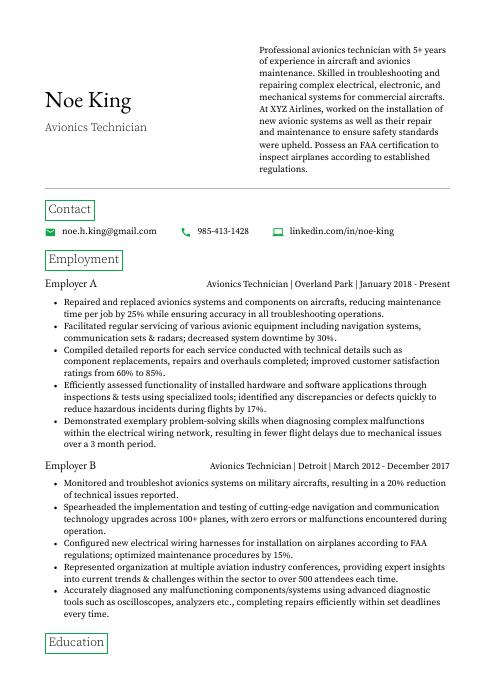 Quokka
Quokka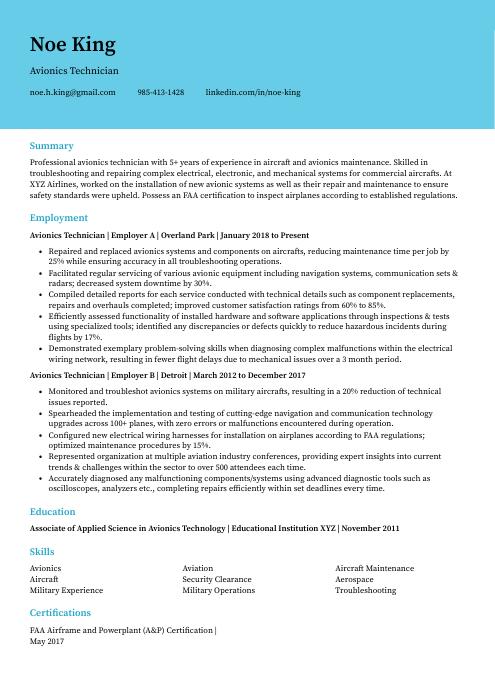 Dugong
Dugong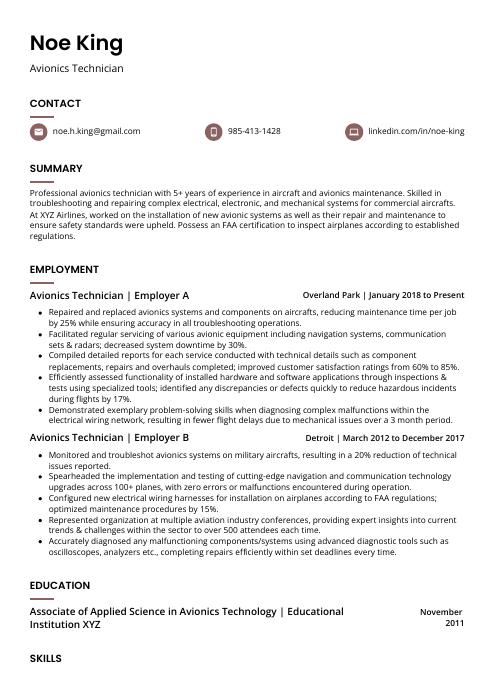 Fossa
Fossa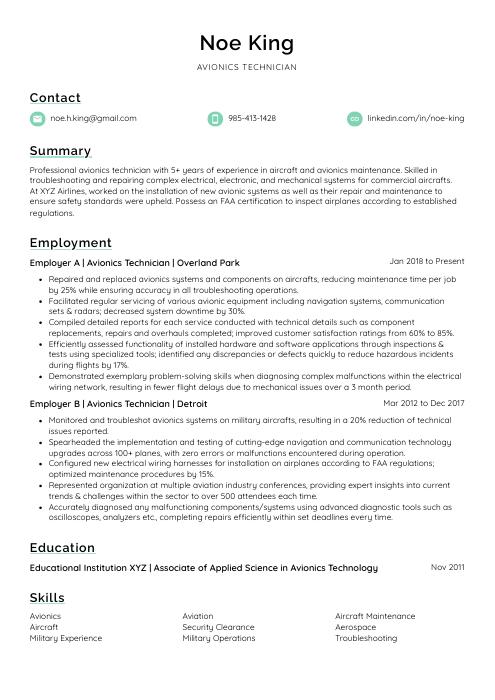 Lorikeet
Lorikeet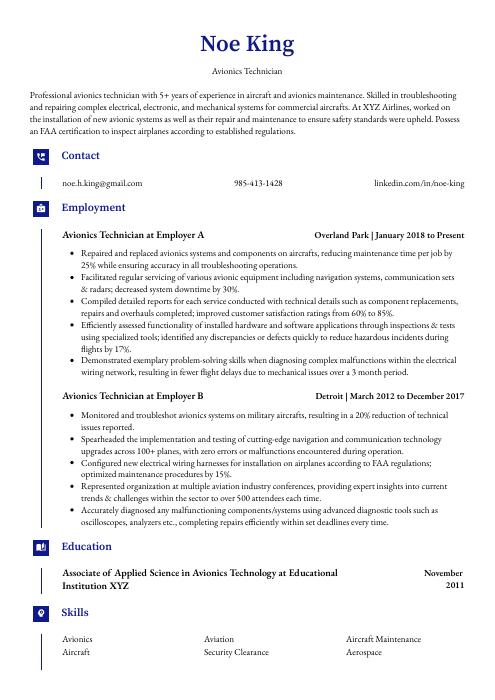 Gharial
Gharial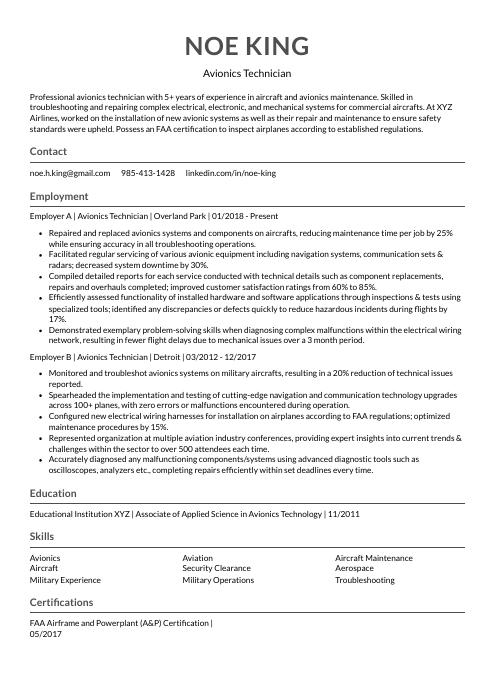 Indri
Indri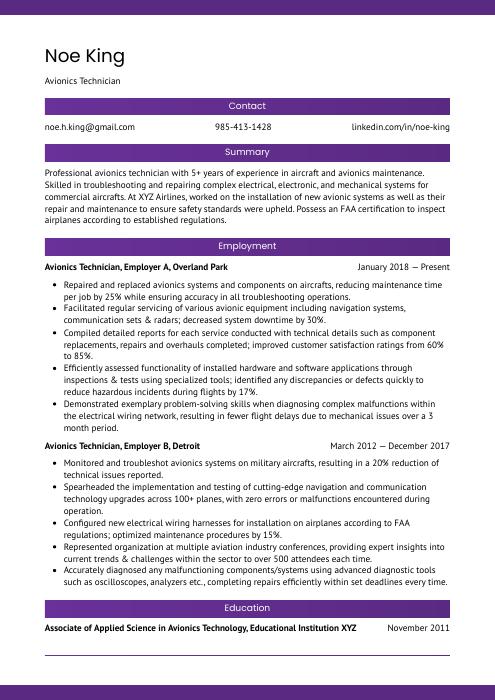 Jerboa
Jerboa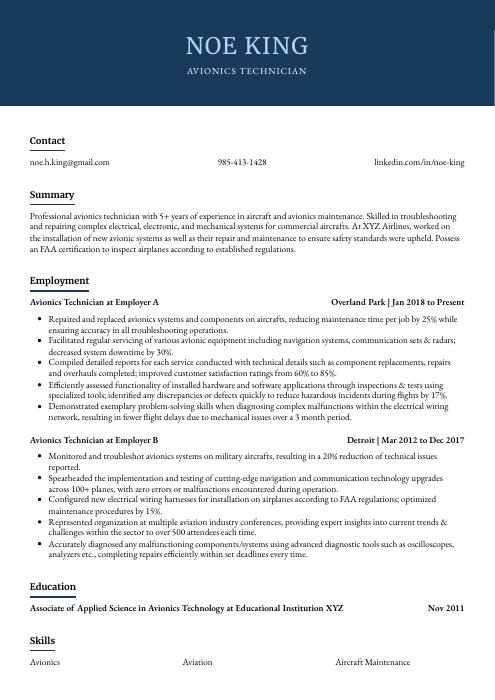 Bonobo
Bonobo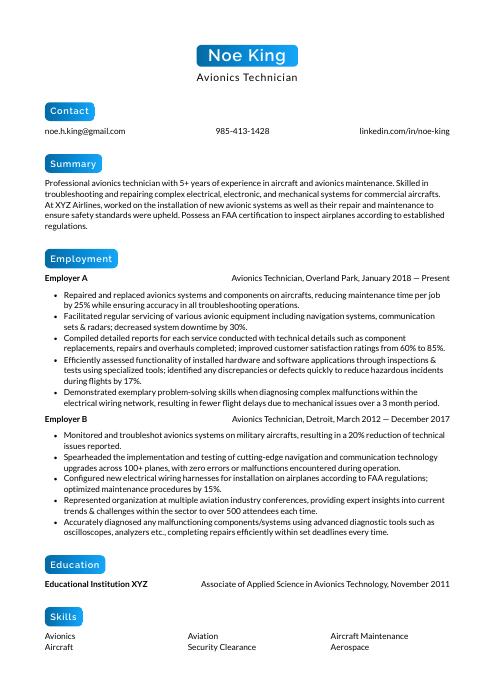 Kinkajou
Kinkajou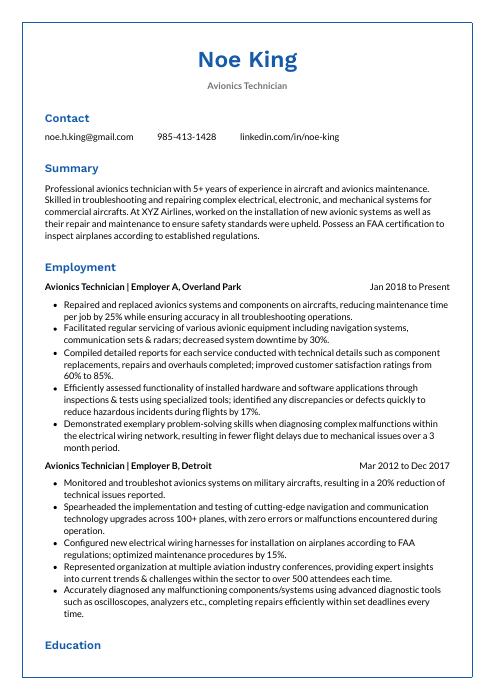 Markhor
Markhor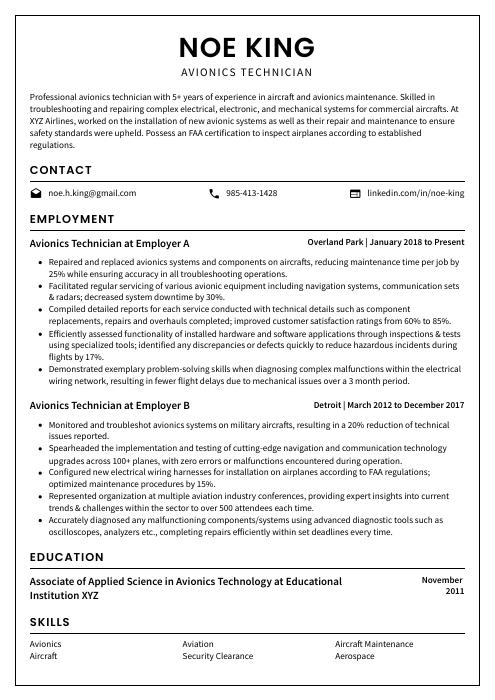 Cormorant
Cormorant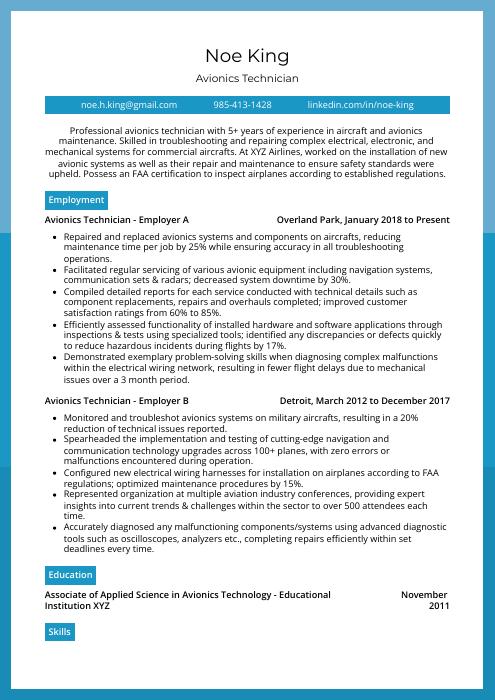 Rhea
Rhea Rezjumei
Rezjumei
